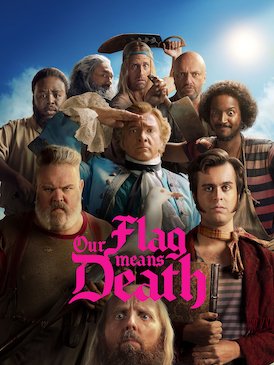
Last month, the show “Our Flag Means Death” (OFMD) debuted on HBO Max. Since then, it has taken niche corners of the Internet by storm—while not a wholly mainstream show, OFMD has rapidly gained a dedicated fanbase. With easily palatable costumes, sets, plot and characters that appeal to viewers from all walks of life, the show drew an audience as diverse as its contents.
A period romantic comedy set in the Golden Age of Piracy, OFMD follows the Gentleman Pirate Stede Bonnet (Rhys Darby) and his crew aboard his ship, the Revenge. Bonnet gives up his unhappy marriage and position of power as an English aristocrat to pursue piracy and make his own way in the world. Along the way, he meets Edward Teach, also known as the famed pirate Blackbeard (Taika Waititi), and his pirate crew. Overcoming one-sided animosity, the two eventually join together in their escapades.
OFMD’s appeal can be broken down into three components. Two of them are common to most media—historical accuracy and sets and costumes. The third has become prominent recently—LGBT+ representation. These three categories encapsulate the major highlights and detriments of OFMD. A disclaimer is in order: while spoilers in the article are minimized, they are still present, so if one really wants to watch this show without them, one should probably stop reading here.
The representation in this show brought me nothing but comfort and joy at seeing myself represented in a way that didn’t alienate or martyr my identity.
— Sophia Meytin
Historical Accuracy
Seeing as OFMD is a period media set around 1717, the historical components of the show are fairly key. However, as a comedy, the show is bound to not hold everything to the full truth. Overall, OFMD does a great job of balancing historical accuracy and comedic deviation. Well-known historical figures, namely Blackbeard and (to a somewhat lesser extent) the Gentleman Pirate, engage both people with a casual interest in piracy and those with a more in-depth understanding of its historic context. The framework of Stede Bonnet’s life as the basis of the show only enhances this effect. That being said, OFMD takes liberties with the humor, dialogue and overall course of events within Bonnet’s life. This helps make the historical aspects of the show palatable to general audiences, who are likely not watching OFMD for its chronological nuance or accuracy. All the same, sometimes the jokes clash slightly with the setting, mainly because they end up being a little corny—mild and expected, but nonetheless detrimental.
Rating: 4/5
Sets and Costumes
The sets of OFMD are generally fairly consistent, but this isn’t a particular fault—after all, a large chunk of it takes place at sea. Costumes, on the other hand, are a different matter. In many period shows, the costumes match the historical era, which, in this case, would be lavish and over-the-top. However, OFMD doesn’t showcase costume diversity as much as it should. The only two major characters with more detailed costumes are Blackbeard and Bonnet, and out of these two only Bonnet has a consistently changing wardrobe. Most of the other characters tend to have set costumes that don’t showcase the different fashions and trends of the time, instead dressing in rags or typical “striped shirt and pants” sailor attire. From a historical perspective, their wardrobe would likely have been more expressive—as a seemingly well-off crew, they would have access to different cuts of clothing, from full-skirted coats to long waistcoats or vests. Moreover, the early 18th century saw the advent of brighter fabrics whose color didn’t dull from wear, so it is likely that even pirates’ rags would have been more vibrant than muted gray or neutral tones. From varying coat styles to colorful fabrics, this time period’s fashion had more to offer than OFMD showed, even within the scope of economy and practicality for sailors.
Rating: 3/5
LGBT+ Representation
The diversity featured in OFMD’s characters is one of the biggest highlights of the show. A large part of this lies in how the show treats diversity—it is normalized and accepted, rather than having a big deal made out of it for “woke points.” The romantic plotline of this show runs not between Bonnet and the evolution of his unhappy marriage, but rather between Bonnet and Blackbeard. Their relationship has its ups and downs, but ultimately leaves viewers hoping for a happy ending—the focus is on the dynamic of the relationship, rather than its LGBT+ nature, and there is no major “internal conflict” where Bonnet and/or Blackbeard have to battle homophobes or reconcile with their inner demons. A number of other pirates are also seen presenting as LGBT+, and this isn’t a big deal for them, either. Similarly, one of the pirates, Jim (Vico Ortiz), comes out as nonbinary, and they are accepted by the crew effectively without question; seeing this nonbinary pirate played by a nonbinary actor reflects the growing acceptance of not only the show’s fictional cast, but its literal one as well.
To break from the less personal tone of this article, the LGBT+ representation in OFMD was meaningful to me. As a queer person, it felt like a breath of fresh air to see LGBT+ life incorporated seamlessly into the show. I didn’t have to worry about feeling ashamed or disgusted with myself because of Jim being harassed for their gender, or for Blackbeard and Bonnet being heckled for being in love. It was also nice to have LGBT+ characters be treated as more than their identity for once—too often, they are reduced to caricatures and only focused on for their struggles, rather than being seen as regular people. Watching a pirated episode of OFMD with my girlfriend after prom, I related to the gay, pirate main characters. Seeing Ortiz play Jim without hiding their identity helped me feel more comfortable in my own skin as a nonbinary person. The representation in this show brought me nothing but comfort and joy at seeing myself represented in a way that didn’t alienate or martyr my identity.
Rating: 5/5
Conclusively, this show exceeds expectations in almost every regard. Any shortcomings that it had were easily surpassed by its positives and each episode was engaging and funny. OFMD is a must-see for anyone interested in historical piracy, contemporized romance or simply a good laugh.


































